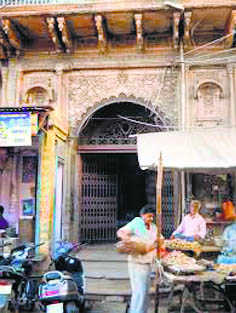Quite contrary to the well-known abodes of the Gandhi-Nehru family like Anand Bhawan, 10 Janpath and 1 Safdarjung Road, this place was almost neglected by the first political family of the country.
If you are a Dilliwala and have a fair knowledge of the lanes and bylanes of Delhi-6, you would surely know as to why the crumbling Haskar Haveli at Sitaram Bazaar holds a special meaning for the Gandhi-Nehru family.
It was at Haskar Haveli that Jawaharlal Nehru came in a full-fledged band-baja baraat to marry Kamala Kaul on February 8, 1916. When Nehru was at Harrow, his parents had started looking for a suitable match for their son. After much effort, they found Kamala, from a middle-class family, in 1912. She was 13 then. Brought up in a traditional Kashmiri Brahmin family of old Delhi, Kamala was a simple and reserved girl. She was born on August 1, 1899.
Rajpati and Jawaharmal Kaul were her parents. Kamala had two brothers, Chand Bahadur Kaul and the botanist Kailas Nath Kaul, and a sister, Swaroop Kathju. Except for spending some years in Indraprastha Hindu Girls’ School, which is just opposite Jama Masjid, all her schooling had been at home, under the guidance of a pandit and a maulvi. It is said that she did not know English.
And the Nehrus waited till 1916, when Kamala attained the age of 17.
Cut to the present. You can see only the ruins of Haskar Haveli. The worst thing is that even people in and around Ajmeri Gate and Sitaram Bazaar would not be able to tell you the exact location.
It is said that a very large number of Kashmiri Pandits had shifted to Delhi and other places like Agra and Allahabad between 1850 and 1900. Among them were the Kunzrus, Haskars, Rehus, Dars, Takrus, Kauls, Zutshis, Katjus and Rainas. The elders of Kamala too had migrated to Delhi during those years. They built their big haveli in Sitaram Bazaar. Some of the havelis of those Kashmiris are still there in Sita Ram Bazaar and Gali Kashmiriyan area of Delhi-6.
The descendents of those Kashmiri migrants speak Hindustani, not Kashmiri. They prefer the local cuisine than wazwan and other Kashmiri cuisine. The Kaul family sold their haveli in the early 1960s. That sealed the fate of this haveli. Nevertheless, the Haskar Haveli had seen salad days in the past as it used to host a number of mushairas and musical programmes.
It is said that Indira Gandhi came to see the birthplace of her mother in the 1980s with her close aides RK Dhawan and HKL Bhagat. She spent around 30 minutes in the haveli and got very emotional seeing her mother’s house.
Delhi-based architect Deepak Mehta feels the Haskar Haveli can be easily restored, like similar havelis in the area.
The local Congress unit had made efforts to get the Haskar Haveli converted into either a school or a library, but perhaps the governments never heeded to this request. Meanwhile, the Haskar Haveli with a rich past is in a bad shape due to a protracted legal battle among the owners.
The writer is based in Delhi
Unlock Exclusive Insights with The Tribune Premium
Take your experience further with Premium access.
Thought-provoking Opinions, Expert Analysis, In-depth Insights and other Member Only Benefits
Already a Member? Sign In Now










